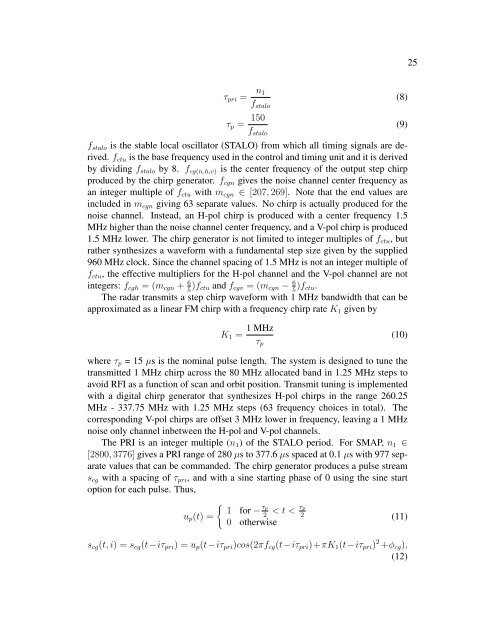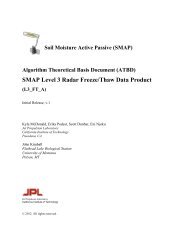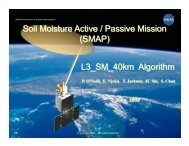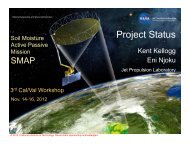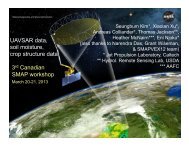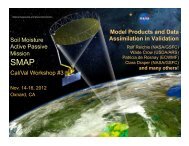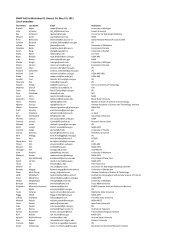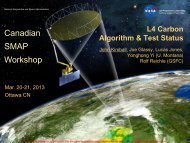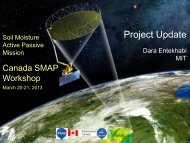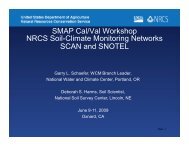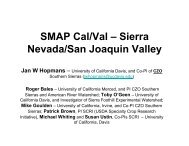(ATBD) SMAP Level 1 Radar Data Products - NASA
(ATBD) SMAP Level 1 Radar Data Products - NASA
(ATBD) SMAP Level 1 Radar Data Products - NASA
Create successful ePaper yourself
Turn your PDF publications into a flip-book with our unique Google optimized e-Paper software.
25<br />
τ pri = n 1<br />
f stalo<br />
(8)<br />
τ p = 150<br />
f stalo<br />
(9)<br />
f stalo is the stable local oscillator (STALO) from which all timing signals are derived.<br />
f ctu is the base frequency used in the control and timing unit and it is derived<br />
by dividing f stalo by 8. f cg(n,h,v) is the center frequency of the output step chirp<br />
produced by the chirp generator. f cgn gives the noise channel center frequency as<br />
an integer multiple of f ctu with m cgn ∈ [207, 269]. Note that the end values are<br />
included in m cgn giving 63 separate values. No chirp is actually produced for the<br />
noise channel. Instead, an H-pol chirp is produced with a center frequency 1.5<br />
MHz higher than the noise channel center frequency, and a V-pol chirp is produced<br />
1.5 MHz lower. The chirp generator is not limited to integer multiples of f ctu , but<br />
rather synthesizes a waveform with a fundamental step size given by the supplied<br />
960 MHz clock. Since the channel spacing of 1.5 MHz is not an integer multiple of<br />
f ctu , the effective multipliers for the H-pol channel and the V-pol channel are not<br />
integers: f cgh = (m cgn + 6 5 )f ctu and f cgv = (m cgn − 6 5 )f ctu.<br />
The radar transmits a step chirp waveform with 1 MHz bandwidth that can be<br />
approximated as a linear FM chirp with a frequency chirp rate K 1 given by<br />
K 1 = 1 MHz<br />
τ p<br />
(10)<br />
where τ p = 15 µs is the nominal pulse length. The system is designed to tune the<br />
transmitted 1 MHz chirp across the 80 MHz allocated band in 1.25 MHz steps to<br />
avoid RFI as a function of scan and orbit position. Transmit tuning is implemented<br />
with a digital chirp generator that synthesizes H-pol chirps in the range 260.25<br />
MHz - 337.75 MHz with 1.25 MHz steps (63 frequency choices in total). The<br />
corresponding V-pol chirps are offset 3 MHz lower in frequency, leaving a 1 MHz<br />
noise only channel inbetween the H-pol and V-pol channels.<br />
The PRI is an integer multiple (n 1 ) of the STALO period. For <strong>SMAP</strong>, n 1 ∈<br />
[2800, 3776] gives a PRI range of 280 µs to 377.6 µs spaced at 0.1 µs with 977 separate<br />
values that can be commanded. The chirp generator produces a pulse stream<br />
s cg with a spacing of τ pri , and with a sine starting phase of 0 using the sine start<br />
option for each pulse. Thus,<br />
u p (t) =<br />
{<br />
1 for −<br />
τ p<br />
2 < t < τp 2<br />
0 otherwise<br />
(11)<br />
s cg (t, i) = s cg (t−iτ pri ) = u p (t−iτ pri )cos(2πf cg (t−iτ pri )+πK 1 (t−iτ pri ) 2 +φ cg ),<br />
(12)


